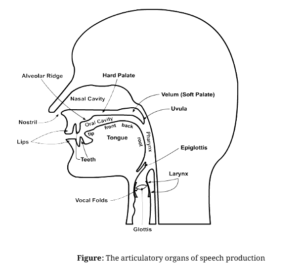Discuss the different organs of speech with a diagram.
- Topic : __ |Writer : __


___ is a notable literary work by ___. A complete discussion of this literary work is given, which will help you enhance your literary skills and prepare for the exam. Read the Main texts, Key info, Summary, Themes, Characters, Literary devices, Quotations, Notes, and various study materials of ___.
Answer
Draw a labelled diagram to show the articulatory organs of speech production.
Or, Discuss the different organs of speech with a diagram.
Speech organs help us produce spoken language. They work together to make different sounds. Air comes up from the lungs below. It passes vocal folds/vocal cords, gets sound, or stays quiet. Then, the sound moves through the pharynx and mouth. The tongue, lips, teeth, and palate shape the sound. Nasal sounds use the nose for airflow. Every speech sound uses several organs together.
The following diagram shows the main organs used for speech production. Let us discuss each important organ and its function.

Lips (Upper and Lower): Lips are at the front of the mouth. We use our lips to open or close. They help in making sounds like “p,” “b,” “m.” Lips can be rounded or spread wide. Different lip shapes give us varied sounds.
Teeth: Teeth are right behind the lips. They help make clear and sharp sounds. Sounds “t,” “d,” “s,” and “z” need teeth. The tongue also touches teeth for clear speech. Teeth help give shape to some words.
Alveolar Ridge: This is a bony structure in the upper and lower jaws. It holds the tooth sockets. The tongue touches it for “t,” “d,” “n.” It helps in making clear, crisp sounds. English uses the alveolar ridge very often.
Hard Palate: This is the hard roof of our mouth. The tongue touches it for some sounds. It is used for sounds like “sh,” “j,” “ch.” It helps in making many English sounds.
Soft Palate (Velum): This is the soft part behind the palate. We can feel it at the back. It moves up to close the nose. Soft palate helps in making “k” and “g.” It directs air to mouth or nose.
Tongue: TheUnlock this study guide now
